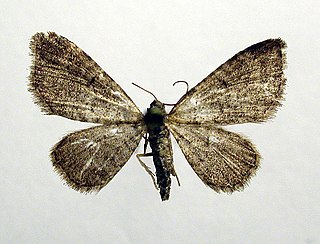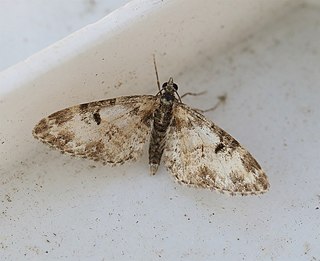
Eupithecia plumbeolata, the lead-coloured pug, is a moth of the family Geometridae. The species can be found all over Europe ranging to the Urals, then through Central Asia to Siberia and to Sayan mountains, the Altai and the Amur. In the Alps, the species occurs up 2000 metres above sea level and in the Pyrenees up to in 2400 metres.

Eupithecia irriguata, the marbled pug, is a moth of the family Geometridae. The species can be found in Europe and North Africa.

Eupithecia venosata, the netted pug, is a moth of the family Geometridae, first described by the Danish zoologist Johan Christian Fabricius in 1787. It is found across the Palearctic realm from Portugal and Morocco in the west to the Lake Baikal in Siberia and Afghanistan and Pakistan in the east.
Eupithecia parallelaria is a moth in the family Geometridae. It is found in Turkmenistan, Iran, eastern Afghanistan and Kashmir.
Eupithecia praesignata is a moth in the family Geometridae. It is found in Afghanistan, Uzbekistan, Tajikistan, Kyrgyzstan, north-western China (Xinjiang), Jammu & Kashmir and India.

Eupithecia ericeata is a moth in the family Geometridae first described by Jules Pierre Rambur in 1833. It is found in most of southern Europe and the Near East.
Eupithecia schiefereri is a moth in the family Geometridae. It is found from North Africa through central Spain, southern France, the central and southern Alps, Italy and the southern Balkan Peninsula to eastern Turkey and northern Iran.
Eupithecia cercina is a moth in the family Geometridae first described by Herbert Druce in 1893. It is found in Mexico.
Eupithecia chrodna is a moth in the family Geometridae first described by Herbert Druce in 1893. It is found in Mexico.
Eupithecia cunina is a moth in the family Geometridae first described by Herbert Druce in 1893. It is found in Guatemala.
Eupithecia inconspicuata is a moth in the family Geometridae. It is found in Turkey.
Eupithecia irambata is a moth in the family Geometridae. It is found in India (Sikkim).
Eupithecia ornea is a moth in the family Geometridae first described by Herbert Druce in 1893. It is found in Panama.
Eupithecia oroba is a moth in the family Geometridae first described by Herbert Druce in 1893. It is found in Mexico and Panama.
Eupithecia pactia is a moth in the family Geometridae first described by Herbert Druce in 1893. It is found in Mexico.
Eupithecia panda is a moth in the family Geometridae first described by Herbert Druce in 1893. It is found in Costa Rica and Peru.
Eupithecia pieria is a moth in the family Geometridae first described by Hamilton Herbert Druce in 1893. It is found in Mexico and Bolivia.
Eupithecia rebeli is a moth in the family Geometridae. It is found in Uzbekistan.
Eupithecia syriacata is a moth in the family Geometridae. It is found in Lebanon, Turkey and Syria.

Lygephila amasina is a moth of the family Erebidae first described by Otto Staudinger in 1878. It is found in Turkey, Lebanon and Israel.




